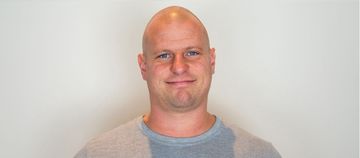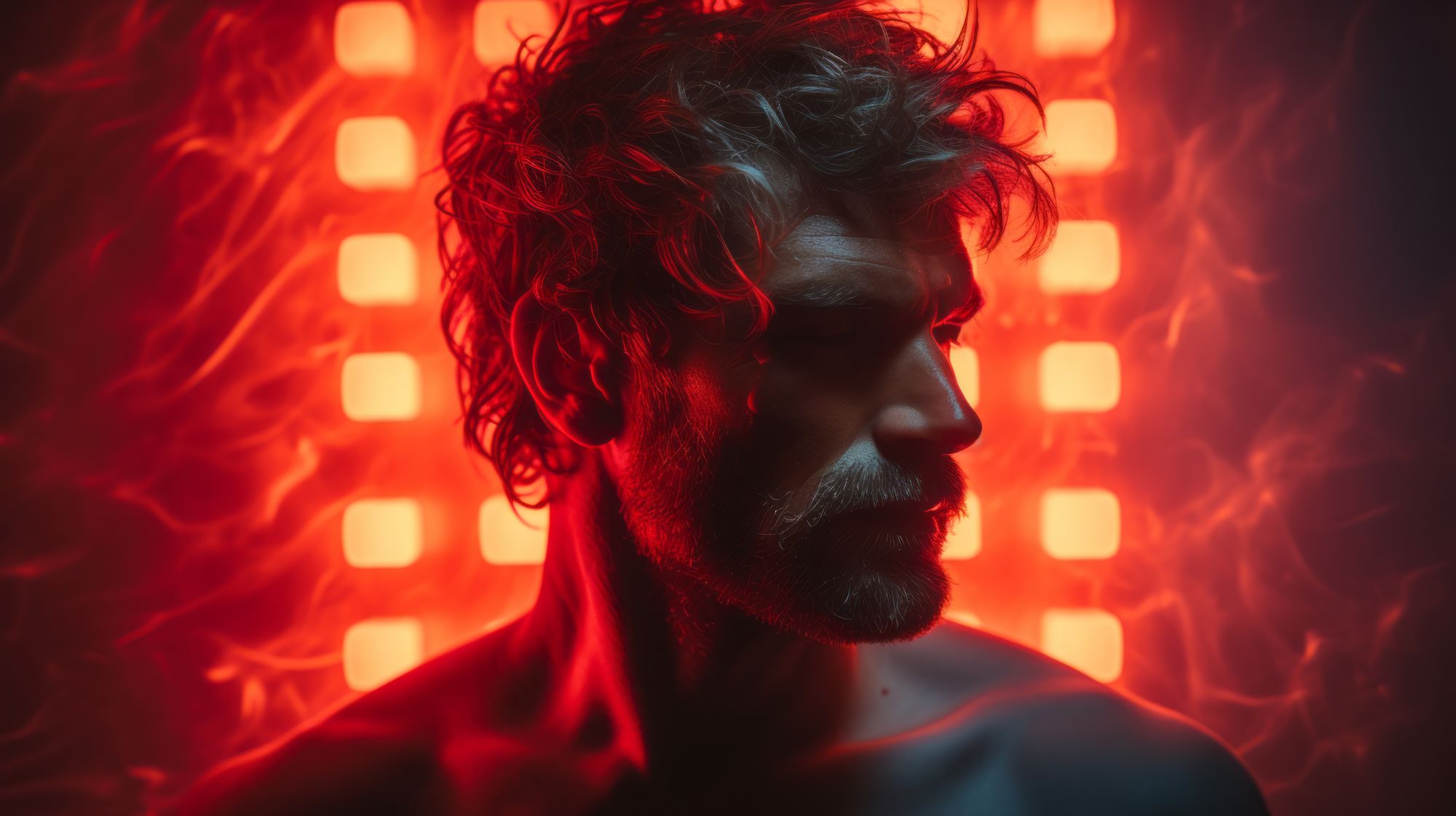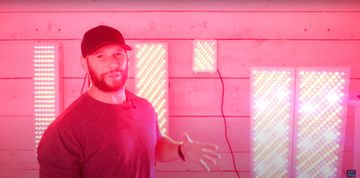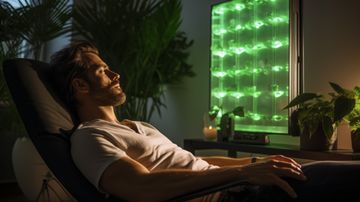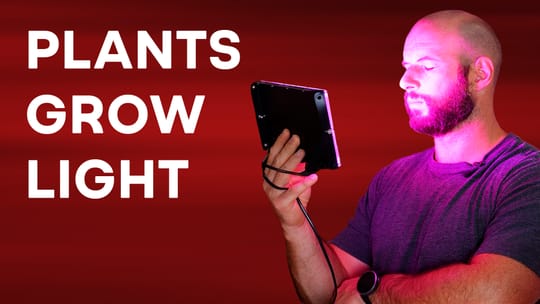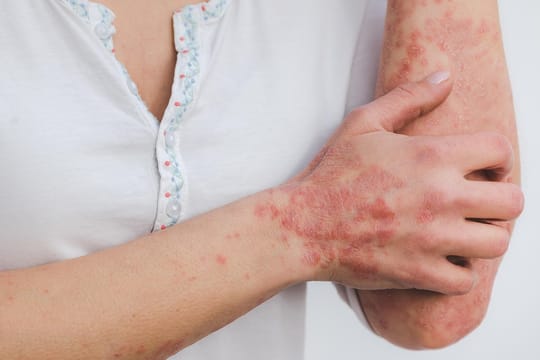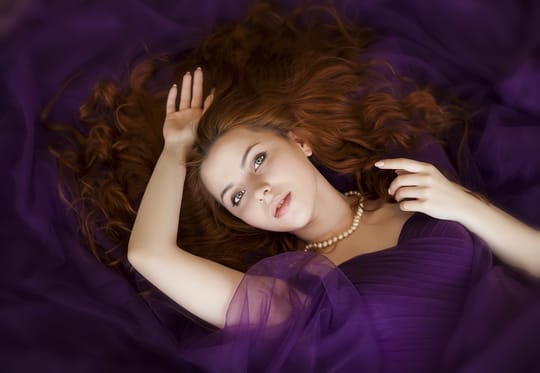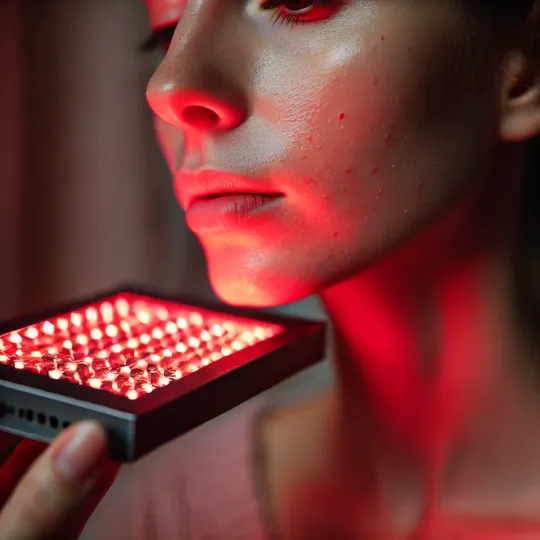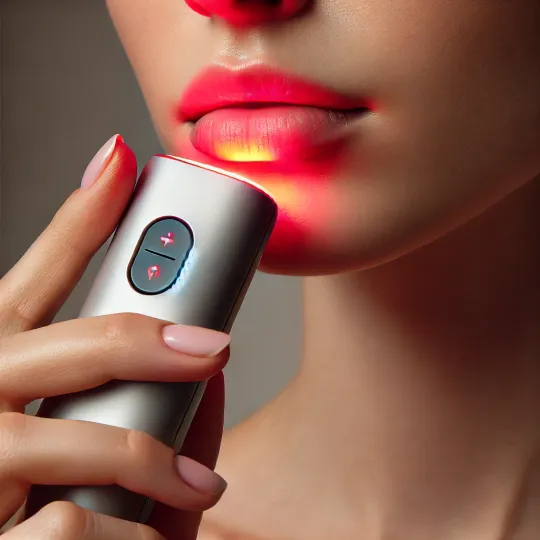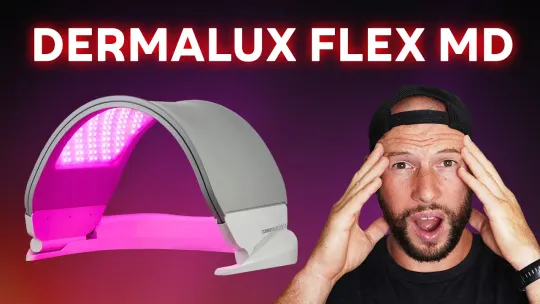In this blog post, I'm considering two essential forms of hair loss, alopecia areata and androgenetic alopecia. Both topics have been studied in great detail in relation to red light therapy. So essentially, this will be a red light therapy for hair loss blog post.
First up, below, I'll give a definition of both types of hair loss and why they happen. To accomplish that I've integrated the latest science on them. Then, I consider all the available science on both alopecia areata and androgenetic alopecia.
This blog post is a bit more male-centered because of the focus on androgenetic alopecia. However, the condition affects women as well and is the most common form of female hair loss as well.
In a future blog post, I'll consider the topic of hair growth, which has a separate but equally interesting list of publications about the topic.
Let's begin with the beginning though, on the topic of hair loss:
Summary: Red Light Therapy For Hair Loss, Hair Health And Hair Thickness
- Different types of hair loss affect as much as 50% of the world population. Androgenetic alopecia is the most common hair loss. Hair loss has a huge psychological burden on many people and solutions are thus extremely welcome. Hair loss often decreases quality of life.
- Many current treatments such as creams and prescription medications have side effects. Sometimes these side effects are horrible and therefore not worth it if you want to stay in optimal health.
- Fortunately, in the last decades and especially the last few years, dozens of studies using red light therapy for hair thickness and hair loss have emerged, at least for androgenetic alopecia. Almost all of these studies are unanimously positive.
- The 650-660nm wavelength interval has by far the best evidence for countering hair loss. Secondly, there's some evidence that 620-630nm has positive effects as well, although it hasn't been investigated that much. Unfortunately, almost zero studies investigated the near-infrared spectrum for hair loss to the best of my knowledge.
- The treatment protocol for red light therapy for hair loss should be three or four times per week. LEDs work just as well as lasers.
- While many studies use helmets or caps for treatment, you could also save a lot of money and use a budget red light therapy panel. Alex has reviewed some of the best budget red light therapy panels on the blog and budget panels on YouTube.
- Alternatively, most people will do even better with a full-body setup. Alex's Quad BioMax setup is an example thereof. The only area you wouldn't directly hit with the light would be the top of your scalp. But that problem is easily fixed by holding your head towards the panels for a few minutes.
- Most people will have the most health benefits by far by building out a full-body setup. And, as any panel on the market almost emits the 660nm wavelength or 630 and 660nm, it's almost impossible to go wrong here.
- For alopecia areata, only a few studies are available. These studies show that ultraviolet-A and near infrared light across the entire spectrum may be helpful - more high-quality research is needed to confirm these effects. Alopecia areata's is an autoimmune and genetic condition that has a hormonal component as well.
- Zooming out, I believe that light deficits - from spending too much time indoors and not enough in sunlight - are a main underlying cause many people have hair loss. Both types of hair loss are affected by red and near infrared and alopecia areata seems to have a large ultraviolet-A component. If people in modern society spend 80-90% of their time indoors then this may explain why as many as 50-60% end up with one form of hair loss or another.
- If you don't want to spend more time in the sun then check out the best red light therapy panels for hair loss section in the table of contents on the left side of the page.
Also, if you want a video version of this topic - that only goes through the basics - check out Alex Fergus' video here:
Introduction: What Are Alopecia Areata And Androgenetic Alopecia - Two Important Types Of Hair Loss?
Throughout the last few decades, a lot has been written about the psychological impact that hair loss has on people (1; 2; 3; 4; 5). Simply put, hair loss often causes a huge psychological burden on different people.
How you respond to hair loss does differ from person to person, though. Me, for instance, when I had some hair loss at the front of my head in my early 20s, just shaved my head and never worried about the problem again. But not everyone is the same in that regard.
Hair thinning is similar. People can become embarrassed, extremely conscious of themselves, may be depressed and even jealous of others. Anxiety and self-esteem issues are other associated problems.
Studies even objectively show that people with hair loss tend to have lower self-esteem than those without. Other effects are the feeling that you're getting older and the fear that the condition progresses into even more hair loss. For many men and women, the social life is negatively affected. So hair loss causes stress, and paradoxically, stress also causes hair loss.
Stress, in fact, is one of the main causes of hair loss in the first place - assuming we're talking about androgenetic alopecia here. But what's the difference between these two types of hair loss anyway? We'll explore in the next section
What Is Androgenetic Alopecia, How Is It Caused, And What Are The Consequences?
"Androgenetic alopecia" isn't a single thing: the condition differs for men and women (6; 7; 8; 9; 10; 11; 12). The term "androgenetic" is thus a misnomer, as it assumes that only men are affected by the condition. And, alopecia can simply be translated to hair loss. So the condition originally meant "male hair loss", incorrectly.
So a difference can be made between female androgenetic alopecia and male androgenetic alopecia. In female androgenetic alopecia, there's usually thinning of the hair on the center of the scalp. The hair at the front of the scalp is usually unaffected, unlike males. Often, there's progressive thinning of the hair in females but there are no direct spots where no hair grows any longer. Usually, women also have hair loss problems at a later age than men.
Sex hormones can be the main reason for the hair loss. However, these sex hormones aren't necessarily male in nature, as androgens (male hormones) are the cause of the problems only in a third of cases in females.
So, "female pattern hair loss" may be a far better term than female androgenetic alopecia. Nevertheless, in that third of cases, hormonal imbalances might result of polycystic ovarian syndrome (PCOS), high prolactin or high stress hormone levels due to different causes, or even tumors. Sometimes, female pattern hair loss results a few months after a period of extreme stress.
The diagnosis of female androgenetic alopecia is usually made clinically though, based on empirical evidence. Lab testing for hormonal abnormalities might also occur. Sometimes the lab testing is necessary to distinguish between female androgenetic alopecia and other types of hair loss, due to autoimmune conditions or scarring for instance.
The problem with female androgenetic alopecia is that it's progressive. So once it starts, the goal is to stop progression as quickly as possible. So that's where red light therapy hopefully comes in later.
The most common treatment is to use prescription drugs for this condition. For instance, minoxidil may be used on the skin. Or, anti-androgenic medications may be taken orally. These interventions can cause side effects, which is why it's so important to check whether red light therapy for hair loss is a more conservative option.
It's not just hormones causing the hair loss though. Genetics also play a major role in androgenetic alopecia in general. And, with 50% of the world's population affected, many people are probably praying on their knees at nighttime in the hope that they find a natural solution to retain their hair or even grow it back. To be more precise with these numbers, 85% of men are affected by alopecia and 40% of women.
Also, white people are most frequently affected. Asians are next, followed by blacks and other races.
Male androgenetic alopecia is a bit different than female pattern hair loss. In the male version, the hair loss is mostly present at the front of the scalp and at the backside of the head. From there, the hair loss often progresses. Men too, apply minoxidil on the skin and may take anti-androgens such as finasteride. In the natural health and wellness space, the latter are well-known for causing horrible side-effects. Male pattern hair loss or baldness can start in the early 20s and 30s.
Fortunately, red light therapy already is an FDA-approved intervention for hair loss right now. So the goal of this blog post is not to consider whether red light therapy for hair loss really works but instead how well it works and how to exactly apply it for the best results. Other therapies for hair loss are hair transplants, platelet rich plasma, nutritional interventions, other hormone therapies and others. Except for well-executed hair transplantations, there's no standardized intervention that almost universally works well regardless of circumstances (13; 14; 15).
Fortunately, the safety and effectiveness of surgery for male and female pattern hair loss has improved in the last few decades, making it an option people use more and more frequently. But even hair transplantations don't work 100% of the time though, due to different circumstances. For instance, if underlying health conditions or medication use cannot be fixed, a transplantation might not be successful.
What's essential here is to remember that if an underlying condition causes the male or female pattern hair loss, red light therapy will probably not fix the problem by itself. For instance, if you have thyroid problems or an iron deficiency that causes hair loss, or have insanely high stress levels, red light therapy won't fix the underlying cause of the hair loss. Other systemic diseases and even STDs can cause hair loss, which need to be dealt with if they're the cause.
So what exactly happens in androgenetic alopecia? A review study states the following:
"Androgenetic alopecia is characterized by progressive hair follicular miniaturization, caused by the actions of androgens on the epithelial cells of genetically susceptible hair follicles in androgen-dependent areas. Although the exact pathogenesis of androgenetic alopecia remains to be clarified, research has shown that it is a polygenetic condition. Numerous studies have unequivocally identified two major genetic risk loci for androgenetic alopecia, on the X-chromosome AR⁄EDA2R locus and the chromosome 20p11 locus." (10).
Hence, a combination of hormonal changes, genetics, and potential lifestyle factors such as stress are the main cause. In men, male pattern baldness (male androgenetic alopecia) may be related to insulin resistance and metabolic syndrome, if it's at an early age, although not all sources agree here (16; 17; 18; 19).
Suffice it to say this short crash course should have informed you about the basic causes of androgenetic alopecia. You now know a lot more about the health condition than the average person on the street does. Next up, let's consider another type of hair loss that's less common, alopecia areata.
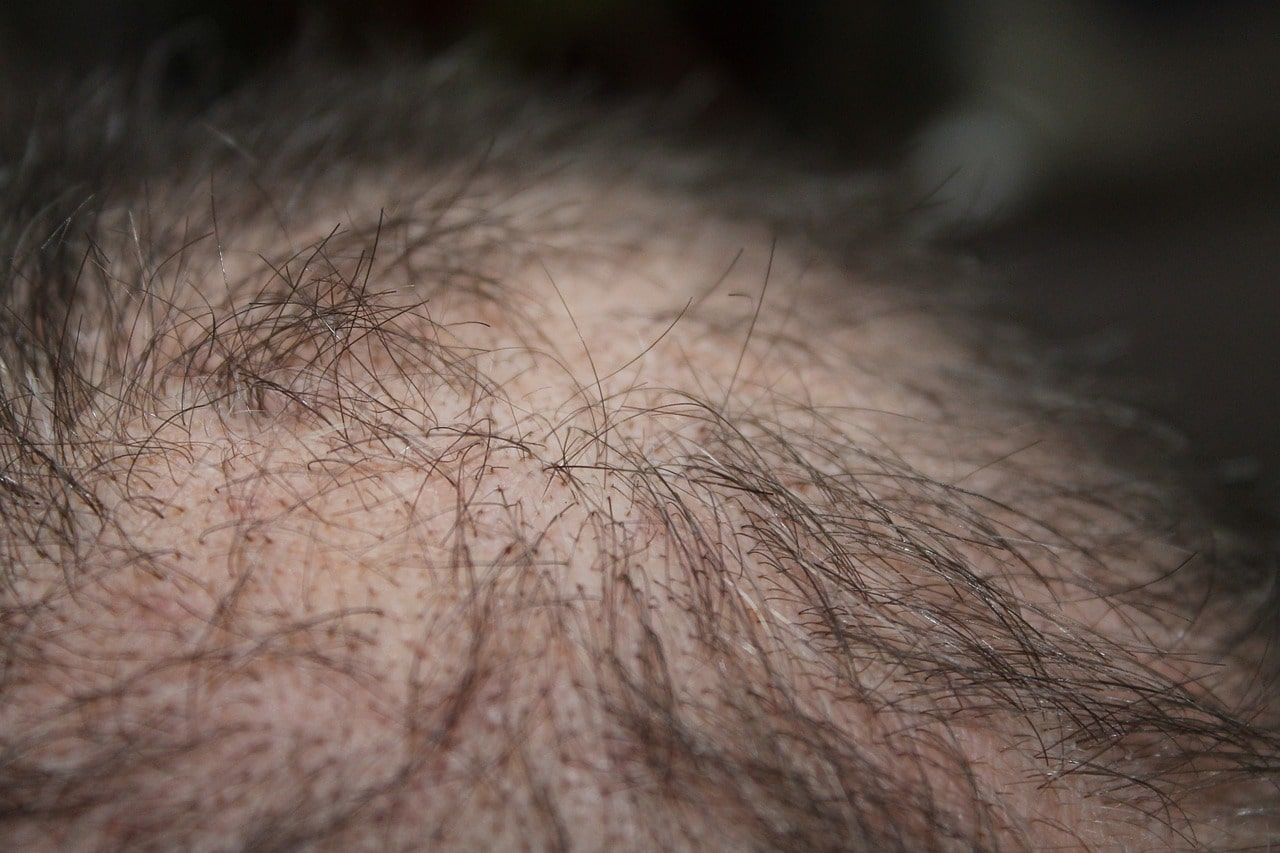
Alopecia Areata: Causes, Standard Treatment, And Progression
Alopecia areata is very different from the male pattern baldness and female pattern baldness I considered earlier. In alopecia areata, genetics and autoimmunity play a major role and hormones far less (20; 21; 22; 23; 24). Alopecia areata is frequently characterized by uneven spots on the head where all hair is lost, in so-called patches. Sometimes, all hair is lost across the entire body. And sometimes, the hair loss is non-patchy although that happens less frequently.
The cause of the problems is that the immune system of the body attacks the hair follicles, leading to hair loss. Current treatment includes systemic health interventions, topical treatment at the place of the hair loss patches, and injections of medication. Alopecia areata is often paired with anxiety and depression, just like androgenetic alopecia. So both conditions have a strong psychological component. The psychological impact is most significant when all hair is lost, which also means that you won't have any hair at the eyebrows anymore, for instance.
Treatment for alopecia areata is also notoriously tricky. No simple intervention exists that lasts and solves the problem. Different health conditions are also associated with alopecia areata, such as thyroid problems, asthma, autoimmune diseases and allergic rhinitis. Contrary to male or female pattern hair loss, however, there's no race, age, or ethnic profile that predicts your chances of getting alopecia areata. Far fewer people are also affected by the latter condition - in the US the number is an estimated 3% of the population.
Why do I still include alopecia areata here? Simple - several red light therapy studies for alopecia areata are available and I want to include them here. And, that's exactly my next step in this blog post, considering the best available evidence, first for androgenetic alopecia.
Best Available Evidence On Red Light Therapy For Androgenetic Alopecia: Systematic Reviews
Fortunately, lots of studies are available on androgenetic alopecia. In this section, I'll first consider so-called "systematic reviews". Systematic reviews in medicine aggregate and summarize all the available evidence on a given topic. So if 20 individual studies exist on a given topic, the systematic review looks at all those 20 studies, determines their quality, and then provides a summary of what the scientific evidence tells you.
And, the good news here is that many different systematic reviews are available. That's probably the case because so many people are affected by male pattern hair loss and female pattern hair loss, incentivizing many people to find a solution.
My first impression here when looking at the evidence in Vladimir Heiskanen's document, is that a lot of positive studies exist on red light therapy for hair loss (25). And, specifically, first, red light therapy for androgenetic alopecia.
In total I count about 35 different systematic reviews. I've focused mainly on the most recent systematic reviews as only those include all the most recent studies. Let's explore these recent systematic reviews one by one and check the findings below.
For each of the findings, I've added a notification whether red light therapy was superior to placebo or not. So if you don't want to read all of the information, you can scan the headers below.
Review 1: A 2023 Study On Combining Red Light Therapy And Minoxidil Medication - Red Light Win!
So, first off, a study that checks how well the combination of minoxidil and red light therapy works for androgenetic alopecia (26). The study concludes that including red light therapy into the treatment protocol, between 600nm and 1,100nm, is often but not consistently superior for countering androgenetic alopecia. The systematic review included five different "Randomized Controlled Trials" - the gold standard in medical research - where there's one intervention group that receives the real treatment and another placebo group that doesn't receive a treatment. Measurement and statistics are then used to check whether the two groups have a statistically significant difference in health outcomes.
Here's what the researchers write:
"Five RCTs compared LLLT with minoxidil (2% or 5%) to 5% minoxidil treatment or LLLT treatment. One study showed combination therapy of LLLT, and 5% minoxidil improved hair density more than monotherapy. Another found combination LLLT with 2% minoxidil induced hair regrowth equivalent to 5% minoxidil. Similarly, another study described LLLT with 5% minoxidil versus minoxidil monotherapy to increase the number of hairs with no statistical difference between groups. One trial found that combination group increased hair regrowth in the first 2 months. The last study found a statistically significant increase in hair density with combined therapy compared to monotherapy." (26).
Unfortunately, I couldn't legally obtain a copy of the full text of the study so I won't analyze this study much deeper. Nonetheless, I am skeptical of the use of Minoxidil. Side effects from minoxidil have been reported for decades now (27; 28; 29; 30; 31). Side effects include excessive hair shedding, skin irritation or irritation of other tissues, a different sweating pattern, and allergic responses. It's also not fully understood how Minoxidil works. However, I'm far more comfortable with the use of Minoxidil than Finasteride - the latter has horrible potential side effects for hormonal health, mental well-being, libido, erectile health, and other domains (32; 33; 34).
Nevertheless, a great win here is that red light therapy reduces the need for the Minoxidil dosage. In turn, your side effect profile changes massively as you may be able to switch from a 5% Minoxidil product to 2%.
Let's explore a few more recent systematic reviews on red light therapy for androgenetic alopecia.
Review 2: 2022 Study Shows Red Light Therapy Is More Promising Than Pharmaceuticals
Then there's another study showing that red light therapy for hair growth works (35; 36). The study is from 2022 so it takes most of the latest research into account. Fortunately, there's also a full text of the study.
The most promising outcome here is that LLLT for hair growth (or in plain English, "red light therapy") is more effective than first-line pharmaceuticals for countering hair loss.
After some time, pharmaceutical interventions didn't work too well. Laser treatments did work better but still not perfectly. Below you can see the effect of different prescription medications and LLLT interventions on hair regrowth:
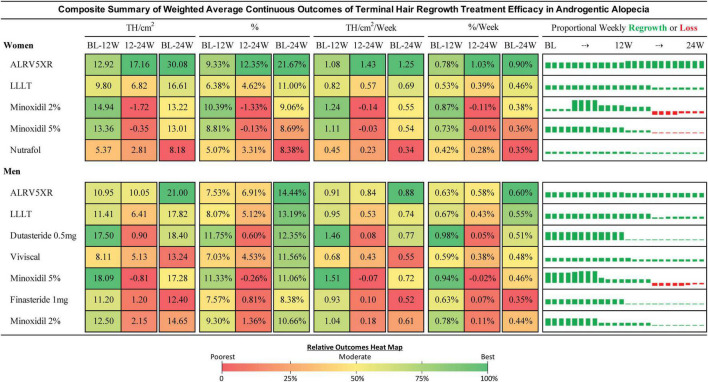
Source: (36)
Here, Nutrafol also has decent effects, although imperfect. Nutrafol is a hair growth and re-growth supplement. There's some nice research showing that Nutrafol really works for hair growth (37; 38; 39). Men and women from various ethnic background benefit from this approach.
Overall, with the systematic review I consider above, I'd love to have seen more treatment parameters of the red light therapy. But we'll probably see these parameters soon in other studies. So let's move on to the next study:
Review 3: Red Light Therapy And Ultraviolet Light Both Superior To Control For Different Hair Loss Types
Then there's another study investigating the effects of red light therapy and even ultraviolet light on some hair loss types (40). Once again, there's no full text of the study available. Nonetheless, the researchers do state the following:
"Two to 4 meta-analyses with different indices were performed separately on 4 groups of studies to test the effectiveness of the following hair loss treatments: ultraviolet light for alopecia areata (AA), red light for androgenetic alopecia (AGA), infrared light for AA, and infrared light for AGA. All meta-analyses showed that treatments were superior to control ( p < .05)." (40)
So, red light specifically is envisioned as helpful for androgenetic alopecia. I'm assuming here the main wavelengths are 630nm and 660nm, even though officially the red part of the light spectrum ends all the way at 760nm (41).
Yes, the ultraviolet light was helpful too, but for alopecia areata, not for male or female pattern hair loss. Bummer!
Review 4: Another Win For Red Light Therapy - A Review That Analyzed 15 Hair Growth Studies
This systematic review from 2021 analyzed 15 different studies and their effects on both male and female pattern hair loss (42; 43). The result?
For both men and women, red light therapy supports hair growth. Well, on its own that's not really informative. So let's consider what the full text of the study states - that full text actually contains a treasure trove of information.
The researchers state that it's not fully known exactly how red light therapy stimulates hair growth. However, several mechanisms of action are proposed. First, there's an increase in ATP production. Traditionally, ATP is seen as the main energy currency of the cell, although I'm not a full proponent of that theory because of Gilbert Ling's work (44; 45). But arguably, even under Gilbert Ling's theory, you could easily argue that red light therapy increases energy production.
Then, there's another frequently mentioned mechanism of red light therapy - alternating "ROS" levels or "Reactive Oxygen Species". ROS are a byproduct of energy production but also one of the main proposed drivers of aging. ROS are damaging to tissues in excessive amounts, although they're also healthy.
Thirdly, one of the proposed mechanisms is the induction of transcription factors. Transcription factors play a role in the interaction from DNA to mRA (messenger RNA). As a result, the transcription factors aid protein synthesis and the migration of cells, and help create new cells. As a result of these transcription factors, oxygenation of the tissues may eventually improve.
Fourthly, the researchers speculate that with red light therapy, the use of stem cells improves directly in the areas affected by hair loss. Stem cells are primordial, undifferentiated cells that aren't specialized yet. The body uses stem cells for many different purposes and stem cels can differentiate into new cells wherever they needed. In a sense, they're like building materials for a house that can be used in different ways. Red light therapy stimulates the mitochondria in these stem cells as well, thereby indirectly promoting hair growth. For the nerds among us, the following section is extremely interesting to read:
"The results of LLLT for AGA suggest that the fraction of all the HFs in the anagen phase is increased. This may be due to the ability of LLLT to stimulate the mitochondria in the bulge stem cells. Stem cells are quiescent cells that have adapted to survive in their hypoxic niche. The low metabolic rate of stem cells accounts for their relative quiescence and increased resistance to stress. Because stem cells must last for such a long time, they have to minimize the number of cell divisions they undergo because each division carries a small risk of DNA damage. One of the most damaging agents to the longevity of cells is oxidative damage to DNA and other biomolecules, caused by the ROS that is an inevitable by-product of aerobic respiration. Therefore, stem cells tend to have an overall anaerobic metabolism characterized by low mitochondrial activity and high expression of glycolytic enzymes.[29]So the hypothesis is that when LLLT is delivered to the hypoxic stem cell niche, the rudimentary mitochondria in the stem cells are triggered into action, and mitochondrial biogenesis can take place producing even more mitochondria.[30] Increased mitochondrial activity is accompanied by an increasing demand for oxygen, which is not available in the low-oxygen environment of the niche. Therefore, stem cells have to leave their niche in pursuit of the oxygen they need to satisfy their new metabolism involving oxidative phosphorylation. The burst of intracellular ROS that is observed to follow LLLT [31] may also have a role in triggering the differentiation of stem cells.[32] As mentioned above, the stem cells become progenitor cells, transiently amplifying cells and finally matrix cells as the HFs enter the anagen phase." (43).
Lastly, then, there's a proposed mechanism: red light therapy directly increases the proliferation of cells in the skin and around the hair.
Next up, the researchers also state what type of devices are used and the power output. Here's what the researchers write:
"The most commonly used devices have wavelengths in the range of 650–1200 nm and fluences of 1–10 J/cm2, with a power density of 3–90 mW/cm2. The treatment is usually for 15–20 min, three times a week for 6 months." (43).
This outcome is pretty good as we can easily recreate that exposure pattern with panels. And, a helmet will probably yield a slightly better result for hair loss at the scalp because it's harder for panels to wrap around the head perfectly. The 3-90 mW/cm2 is a very broad range though, although, some of the newest panels on the market such as the Rouge Pro G3 and the Rojo 300 or 3000 panels hit the upper limit of these numbers already.
Fortunately, the full text of the study confirms my suspicions. Most studies use 655nm light, which is the same as 660nm that's included in many red light therapy panels, more or less. Some studies use 632nm and 780nm although these are very rare.
The wavelength with the most evidence for hair loss, specifically androgenetic alopecia, is the 655 or 660nm wavelength. Here I'm talking about animal studies though. That's great news as most red light therapy products already contain that wavelength.
Then there's design. I've written extensively about red light therapy dosing in the past. Total dosages range from a super low 1 and 5 Joules per cm2 to as high as 70 Joules per cm2. Both seem to work well. Nine out of nine studies are positive, showing effects such as increased growth, thickness, and other outcomes.
How about the dosing parameters in human studies? Here too, I mostly see wavelengths around the 655nm so 660nm range. Some studies use other wavelengths such as 780nm light. Total dosages that are listed in the full text of the review are 47.90 Joules per cm2 and 67.3 Joules per cm2. Other total dosages measured in Joules aren't listed in the full text.
So what about treatment frequency? Treatment is generally every day or every other day, and sometimes three times per week. All of these methods seem to work. The researchers state the following about the results in human studies.
"At least more than half of the studies showed an improvement in the hair regrowth in the form of increased hair count, increased hair density and tensile strength, and also the prevention of hair loss among the subjects on whom the studies were carried out. While early trials were small and lacked controls, more recent trials have been larger and better designed and had more effective control groups which improve their validity. All studies showed that repeated treatments of LLLT improved [Androgenetic Alopecia] over time. In the largest randomized controlled trial, Jimenez et al.[50] demonstrated statistically significant hair regrowth by terminal hair count in all patients. HairMaxLaserComb® devices tested, compared with sham controls, in both males and females. Esmat et al.[51] demonstrated efficacy of LLLT when used as concomitant therapy to finasteride and minoxidil, thus suggesting that combination treatment can be useful. This study also showed that LLLT and minoxidil had similar efficacy in hair growth and that combination therapy was even more effective.[51]" (43).
So, you'll end up with hair regrowth, meaning thicker hair and more hairs on the head. These hairs are also stronger. And, hair loss can be prevented. This review also states that it's best to use prescription drugs together with red light therapy for the best results.
I, personally, probably wouldn't use these prescription drugs if I could go back in time. But I'm also happy with my bald head and I've never looked back. I believe bald looks clean and disciplined and the best with my face. I love it a lot more than back when I grew my hair longer, so I'm delighted with the results. I can imagine, however, that men and especially women truly hate it when they no longer have the hair they had in their teens and twenties. So I can fully understand the tradeoff here - take medication in the hope of restoring your hair, but accepting that you might have side effects. The good outcome here is that red light therapy for hair growth can at least reduce your reliance on these prescription drugs.
Side effects from red light therapy for hair growth are also extremely rare. And, if they occur, then they immediately go away after using the therapy and are non-serious in nature. So the safety profile is extremely good here and there's no downside in using red light therapy as a first line of defence once hair loss starts.
Then there's a systematic review I skipped because it doesn't have a full text (44).
Review 5: FDA-Approved Devices For Androgenetic Alopecia - 650nm And 655nm Make Up The Bulk Of Hair Loss Studies And Work Well Without Serious Side Effects
Next up, a study checking FDA-approved devices for androgenetic alopecia (45; 46). The study talks that as of January 2020, 32 FDA-approved devices exist for androgenetic alopecia. Nevertheless, I do want to say something about these devices.
Table 1 of the full text of the study, for instance, compares 34 different FDA-approved hair loss devices. All have between 7 and 227 LEDs or lasers. And, almost all of these devices emit light in the 650nm or 655nm range, except for two products that emit light at 678nm and one uses 620nm. Treatment time with all these devices is two to four sessions per week, almost without exception The total power output between the weakest and strongest devices differs about 30-fold. Prices of these products range from $279 to $2,999 USD. Some of the products have evidence backing up their effectiveness. Most of these products, moreover, use lasers, not LEDs.
I do want to go deeper into these findings and draw some lessons. First, it seems that for a proven product for hair loss, hair thickness, hair tensile strength - all of which are outcomes of this study - you'll predominantly have to use 650nm and 655nm. Of course, red light therapy panels that emit lots of light at 660nm will emit a lot of light at 650 and 655nm as well.
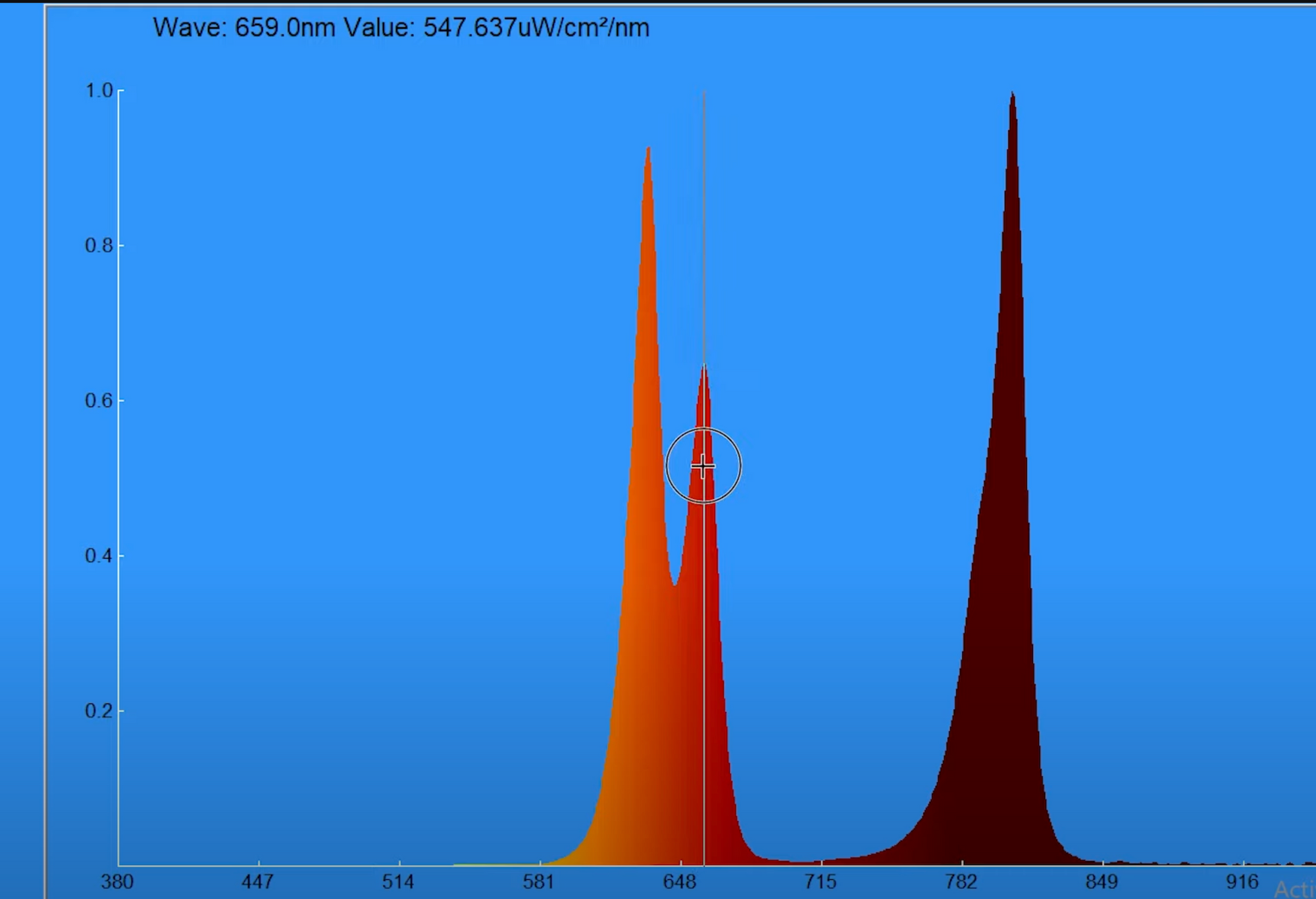
Secondly, it seems that a 2-4 times per week treatment option is best. In the studies, the 3-4 times per week and every other day (which comes down to 3.5 times per week) is most frequently used.
Thirdly, I do think many of these devices are extremely expensive. I also wonder whether you won't simply recreate the same effects with a red light therapy panel. It's probably very easy to reach the same power densities that these caps achieve if you simply have one or more high-powered panels and then turn around during your sessions.
Fourthly, when taking into account the studies that aren't necessarily FDA-product related, the 630nm wavelength and those around it such as 635nm pop up more. You can see those in table two of the full text of the study (46).
Fifthly, side-effects are extremely rare and mild. These side effects include parasthesia (different sensations than normal), hives on the skin, headaches, itchy skin, skin irritation, warm sensations, and scalp tenderness. None of these side effects are really serious.
Sixth, overall the study outcomes are unanimously positive. So, with a great range of treatment parameters, red light therapy for hair thickness and hair loss seems to work well.
Seventh, many different devices were tested. These included sports caps, helmets, headbands and combs.
Eightly, it seems only the red part of the light spectrum is researched. I would have loved to see some near infrared studies as well. If anyone is claiming that energy generation in the mitochondria matters and the health of the hair follicles, I'd like to see some comparison studies between these wavelengths.
But moving on. Here I skipped one study because it didn't concern red light therapy for hair loss specifically (47). Two other ones didn't have a full text available for free (48; 49). The abstracts of the studies still claimed that LLLT for hair loss has extremely positive outcomes with few to any serious side effects though.
Therefore, let's look at the next review.
Review 6: LEDs Work Just As Well As Lasers For Hair Loss And Are Cheaper
Next up, is a review from 2021 (50; 51). The study explicitly that LEDs work just as well for hair loss as lasers but at a less expensive price. Not much new here though, I think I've gotten most of the lessons from these studies.
What is key and what I've maybe not emphasized enough is that you'll need a 16-24-week treatment time. The reason is that the hair's quantity and thickness increase from the hair follicle. For hair loss specifically - if you've got patches with no hair at all - it generally takes 12-16 weeks for new hairs to grow in the first place, if they weren't.
Also, looking at the results many people are having, it might be nice to make before and after pictures. That way you can more objectively establish whether you've gotten benefits or not.
Overall though, I don't get much new information reading through more and more review articles anymore so I'll leave it at six reviews so far. These six reviews are also the latest reviews published, so they're taking the latest publications into account. Next up, let's go explore red light therapy for alopecia areata.
Red Light Therapy For Alopecia Areata
As stated before, alopecia areata only affects a few percent of the world's population. And the condition can be classified as an autoimmune condition, although hormonal and especially genetical influences play a major role too. In this section, I'll look at the available studies on alopecia areata. Unfortunately, there's very limited data available on alopecia areata. I will therefore tell you about all available data, instead of sticking to review studies because of the overwhelming amount of data on androgenetic alopecia. Here are the results:
- First, there's a 2018 review of LLLT (Low Level Laser Therapy) for Alopecia Areata (52). Interestingly enough, it's not the 660nm or even the 630nm wavelength that is considered most promising here, but the 308nm in the ultraviolet-A range. Out of ten studies, eight used that 308nm wavelength. Another study had good outcomes with 355nm, which is also found in the ultraviolet-A range. Study quality is low though, according to this review, and more human research with more study participants is needed. Preliminary conclusions do find good outcomes with the ultraviolet-A applied to patches on the beard or on the scalp. Interestingly enough that this pattern is so similar to psoriasis, which is also partially autoimmune in nature and also responds extremely well to ultraviolet light exposure (53; 54; 55). The 308nm wavelength, in fact, is exactly the same as frequently used in psoriasis. But let's check whether I can find some red and near infrared light studies as well:
- Next up, there's a 2003 study that does use infrared light (56; 57). The study doesn't mention the wavelength but does state that infrared helps regrow hair after 16 weeks - similar to many of the androgenetic alopecia studies. Almost half of the areas affected by alopecia areata regrew eventually. Only mild forms of alopecia areata were included though.
- Then there's an animal study using 655nm light (58). Treatment was three times per week. After six weeks, hair regrowth was observed in all of the mice. The placebo group of mice that didn't receive a real 655nm treatment didn't grow back any of their hair. Hair follicles increased in the red light therapy-treated group that shifted to the anagen phase, which is the active growth phase for hair. No other studies could be found on this topic.
- I double-checked some systematic reviews on red light therapy for alopecia areata for mentions (59; 60; 61; 62; 63). I also did some manual searches on PubMed to check my suspicion. And unfortunately that suspicion is true: there aren't any other studies than the three I just quoted - technically two if you subtract the review - on LLLT for alopecia areata.
The takeaway? It's probably best, given current evidence, to use a combination of ultraviolet and infrared light. The simplest way you can accomplish this is by sunlight exposure year-round.
But let's take another step back:
My entire takeaway, if you look at the LLLT for androgenetic alopecia and LLLT for alopecia areata is that both are probably caused by a light deficit in daily life. Most people spend most of their times indoors nowadays. Whether you work in an office or working from home, people don't spend much time outdoors anymore.
Different air pollution studies have looked at this and estimate that 80-90% of time is spent indoors in developed countries right now (64; 65; 66). Not everyone might or is able to get into the sun properly every day due to work commitments or other reasons. Hence, it's still vital that I consider what the best red light therapy devices for hair loss are:
Best Red Light Therapy Devices For Hair Loss: Panels, Helmets, Or Different Options?
I've hinted at my conclusion earlier in the section about androgenetic alopecia: I think most people should simply opt for a full-body panel setup. The reason is that most people want the full benefits of red light therapy for their entire body, not just for hair loss. Wouldn't you want better cognition, and more collagen and elastin in your skin for better looks, and better athletic recovery, and deeper sleep, in addition to reversing hair loss?
Additionally, some of the dedicated red light therapy for hair loss helmets are really pricey, especially FDA-approved products. You can pay up to $3,000 USD for an FDA-approved LLLT hair loss device even though a budget red light therapy panel might only set you back $200-300 USD.
So first, I want to direct you to some of Alex's YouTube videos. There you can find the best red light therapy panel for full-sized units and the best budget red light therapy panel for tabletops. The winners of the former competition are the Mito Red MitoPRO 1500, the PlatinumLED BioMax 600 (although the 900 is great too), and the Infraredi Max (the more recent Infraredi Flex Max is even better). Then, there's the budget red light therapy panels. In that category, the winners are the Mito Red MitoPRO 300, Hooga Pro HG300, and the Rojo 300. If you're interested, I recommend checking all the reviews of these red light therapy panels by Alex below:
Full-body panels:
- Mito Red MitoPRO 1500 review - get a panel HERE and use discount code ALEX5 for 5% off.
- PlatinumLED BioMax 600 review - get a panel HERE - you get a discount code after clicking.
- Infraredi Max review - although the Infraredi Flex Max review is recommended. Get a panel HERE and use code ALEX for a 10% discount.
Then, the budget red light therapy panels:
- Mito Red MitoPRO 300 review - get a panel HERE and use discount code ALEX5 for 5% off.
- Hooga HG300PRO review - get a panel HERE and use code ALEX for a discount.
- Rojo 300 review - get a panel HERE and use discount code ALEX to save.
There are some other products worth mentioning that have been released since then. Alex has reviewed these products, such as the Rouge G3 review, the Rojo Therapy 3000 review, the Hooga HG1500PRO review, and the Mito Red MitoAPAPT Min review. I mention these because they might offer more value, or better shipping to your location if you're living in New Zealand or Australia (Rojo), or new features.
Suffice it to say that all of these panels emit 50% of their light in the 630nm and 660nm wavelength spectrum.
Hair Loss In Context: Other Factors Influencing Hair Loss
Well, before I post my conclusion, I do want to say something about other factors that have a huge influence on hair loss. I recently saw an interview of my friend Ari Whitten with Julie Olson on preventing and reversing hair loss. Rather than just assuming whatever they were saying in the interview though, I decided to fact-check the claims in the interview.
A wonderful interview on reversing hair loss. Don't bet on red light therapy for hair loss alone if you've got many other factors, such as diet or stress out of whack in your life!
First off, Julie claims there are four main causes of hair loss:
- Stress-induced
- Inflammatory
- Digestive
- Hormonal
The hormonal option I've discussed in great detail already and the others not. And, the hormonal cause can certainly be researched in more detail, I'll leave it there. For inflammation, although some studies were somewhat older, I did find evidence showing that inflammation is linked to androgenetic alopecia (67; 68; 69; 70). The same is true for digestion although I could barely find any studies there (71; 72). For stress and hair loss the link is extremely solid though (73; 74; 75; 76; 77; 78).
As Ari and Julie mention in the interview, stress can be one of the major causes of hair loss. Even Ari has had experience with that. So, even though I don't see tons of direct evidence for digestive issues and inflammation on hair loss, we'll have to take Julie on her word here because of her clinical experience as a functional medicine practitioner.
The bottom line here is this: if you're using a red light therapy helmet to counter androgenetic alopecia, but you're having sky rocketing levels of psychological stress and your hormones are all out of whack, red light might not fix the underlying hair loss cause.
In that case, you'll have to focus on general health first to fix your hormones and stress levels and the hair may "magically" reappear. Red light therapy might counter stress as well, although it's unlikely that it completely fixes the problem.
Also, in the interview on hair loss, gut health is mentioned as a new way to counter hair loss, that's primarily based on clinical experience I assume and not published science. Mitochondrial health is another such a factor. So overall, my position here is that you'd better focus on general health as well and not only red light therapy for androgenetic alopecia or other hair loss types.
Now, the reason that mitochondria are so important for hair follicles is because hair follicles are really energy-demanding. That's probably also the reason why red light therapy works so well in this case, because it one of the best tools to increase energy at the cellular level.
Julie says, moreover, that in women, lifestyle factors are far more important than in men. In men, hair loss is more genetic, in general. So, gut problems, stress, and hormonal disruptions might need to be fixed before you consider red light therapy in the first place, as a woman. I won't go into much more detail here, I'm pretty convinced this background is massively important and if you want to learn more about hair loss, watch the hair loss interview with Ari Whitten and Julie Olson. You'll learn a lot, for instance, the crazy fact that fecal transplants can reverse some types of hair loss.
Red Light Therapy For Hair Regrowth Frequently Asked Questions
Below I'll answer a few frequently asked questions about red light therapy for hair regrowth or loss:
What Are The Red Light Therapy For Hair Loss Before And After Results?
Most people see results after several weeks of red light therapy. But you don't get guaranteed results. Some people simply have their hair loss progressed too far for an intervention to work.
For instance, check this video for the red light therapy for hair loss before and after of Alex Fergus:
https://youtu.be/0KXOVMyas60
As you can see in the video, Alex barely had any results - if any. But his hair loss was already so progressed despite of years using red light therapy that no good results could be expected anymore - even from a dedicated red light therapy product.
Are There Other Light Treatment For Hair Loss Options?
Sure, light treatment for hair loss exist. Laser hair loss treatments are an example here. But these treatments are generally applied under medical supervision, so you can't use it as a consumer product at home.
Red Light Therapy For Hair Loss: How Long Does It Take?
You should be able to see results in 12-16 weeks at the maximum. If you don't get results, the treatment may not be working. And if the treatment isn't working, you may need to change the device that you're using, or the treatment time, or the way you're using the device.
Unfortunately, there's no simple answer here. The only thing I recommend in this case is to check our video on red light therapy dosing:
https://youtu.be/dynWCpql2ew
So, if you don't get results after 12-16 weeks, try a different dosing protocol! Reduce or increase treatment time, or the distance of the product to your scalp, and so forth. I can't give a simple answer here because the power output and wavelengths differ big time between devices.
Red Light Therapy For Baldness: Does It Really Work?
If you're already fully bald or partially bald, you may no longer get great results. A hair transplant is often a better option in that case. Again, the earlier you start this treatment for hair loss, the better.
Is Red Light Therapy For Female Hair Loss Different?
The treatments I've described above should work independently of your gender. And yes, even though the causes of male and female hair loss differ, red light therapy should work for both!
Can Red Light Therapy Cause Hair Loss?
So can red light therapy cause hair loss? The answer here is, generally not. Only in very rare circumstances such as a very high-powered laser, that's used for hair removal, may red light therapy cause hair loss. And, theoretically, red light therapy may also use hair loss if you overuse it - such as using a device for hours per day, instead of the prescribed minutes.
What Does Red Light Therapy For Hair Loss Video?
If you're interested, check Alex Fergus' treatment of this topic here - I know some people prefer watching videos instead of reading:
https://youtu.be/guku2JeieVo
Finally, let's conclude:
Conclusion: The Hair Loss Treatment Future Looks Extremely Promising
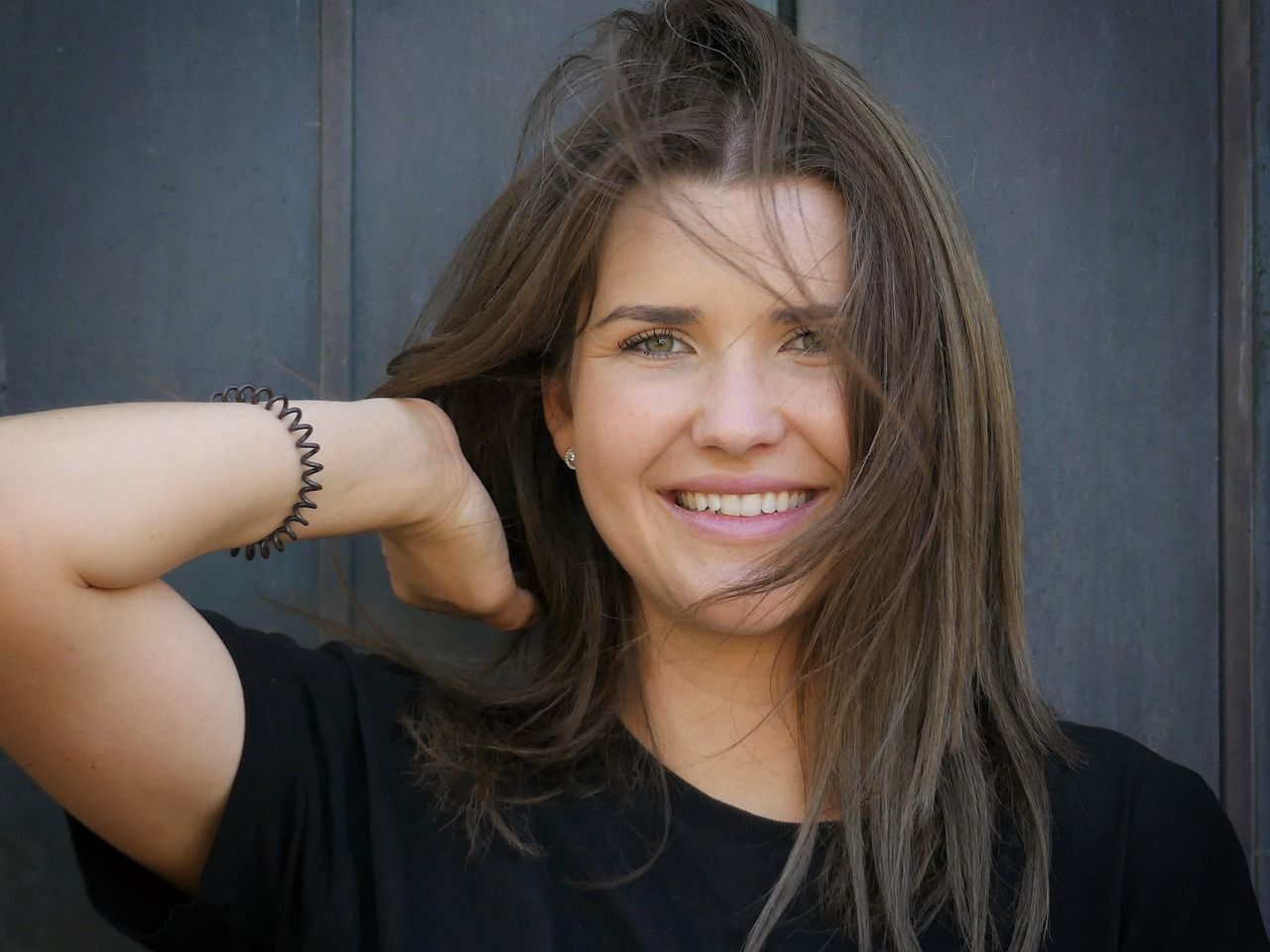
As you can see, plenty of red light therapy for hair loss options out there. Just get a decent budget red light therapy panel or a full-sized one and make sure it hits your hair follicles.
No need to overthink this process too much, except that there can be many underlying reasons why people have problems with hair loss. So, if your diet is poor or you're chronically overstressed, no amount of red light therapy for hair loss is going to save you.
This is a post by Bart Wolbers of Lighttherapyinsiders. Bart finished degrees in Physical Therapy (B), Philosophy (BA and MA), Philosophy of Science and Technology (MS - with distinction), and Clinical Health Science (MS), has had training in functional medicine and is currently chief science writer.
Items Mentioned
- Nutrafol - a hair regrowth supplement.
- Rouge Pro G3 - use code ALEX and one of the following links depending on the country you want to order from:
- For the US use this link: https://aferg.co/rouge-US
- For Canada use this link: https://aferg.co/rouge-CA
- For Australia use this link: https://aferg.co/rouge-AUS - Rojo 300 or 3000 - use code ALEX for a discount
- Mito Red MitoPRO or MitoADAPT - use discount code ALEX5 for 5% off.
- PlatinumLED BioMax - you'll get a discount code after clicking.
- Infraredi Flex Min or Max - use code ALEX for a 10% discount.
- Hooga HGPRO panel - use discount code ALEX for a discount
Found This Interesting? Then You Might Like:
- Start Here - Light Therapy 101 & Buyers Guide
- Discount Codes, Deals & Recommendations - Red Light Therapy
- What Is Red Light Therapy?
- Red Light Therapy Wavelengths Benefits: The Ultimate Guide
- Best Red Light Therapy Panel 2024: EPIC Comparison
- CurrentBody Hair Regrowth: Before & After Surprise?!
- Red Light Therapy For Skin: Beauty Benefits, Potential Complications, And More
